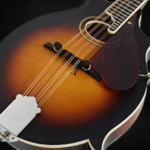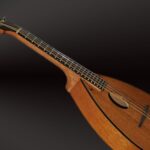Trying to figure out the best cello and cello brand for you can certainly seem intimidating at first. With nearly 20 years of experience playing and teaching cello, I’m bringing you a firsthand look at the best cellos and cello brands on the market for beginners as well as those looking to pursue the cello as a career.
Quick-Look: Best Cellos and Cello Brands
★ #1 Best Cello Overall: DZ Strad Cello Model 250 ★
- Best Cello for Beginners: Cecilio CCO-100
- Best Intermediate Cello: Cremona SC-165
- Best Cello for Professionals: DZ Strad Cello Model 250
- Best Cheap Cello: Merano MC400
- Best Cello Under $1,000: D’Luca MC100 Meister
- Best Cello Under $500: Eastar EVC-1
- Best Wooden Cello: Eastman VC305
- Best Carbon Fiber Cello: Mezzo-Forte
- Best Electric Cello: Yamaha Silent Series
Not only do I recommend the following cellos and cello brands, but I’ve personally played and performed on all of the cellos listed in this article.
What is a Cello?
Invented in 16th century Italy, the cello is one of the most versatile and beautiful instruments. While the cello’s popularity was overshadowed by the viola da gamba at the time, world-renowned composer Johann Sebastian Bach brought the cello to light with his 6 Suites for Solo Cello.
The Suites have grown to be a staple for cellists around the world and are known, still today, as some of the most important compositions of our time.
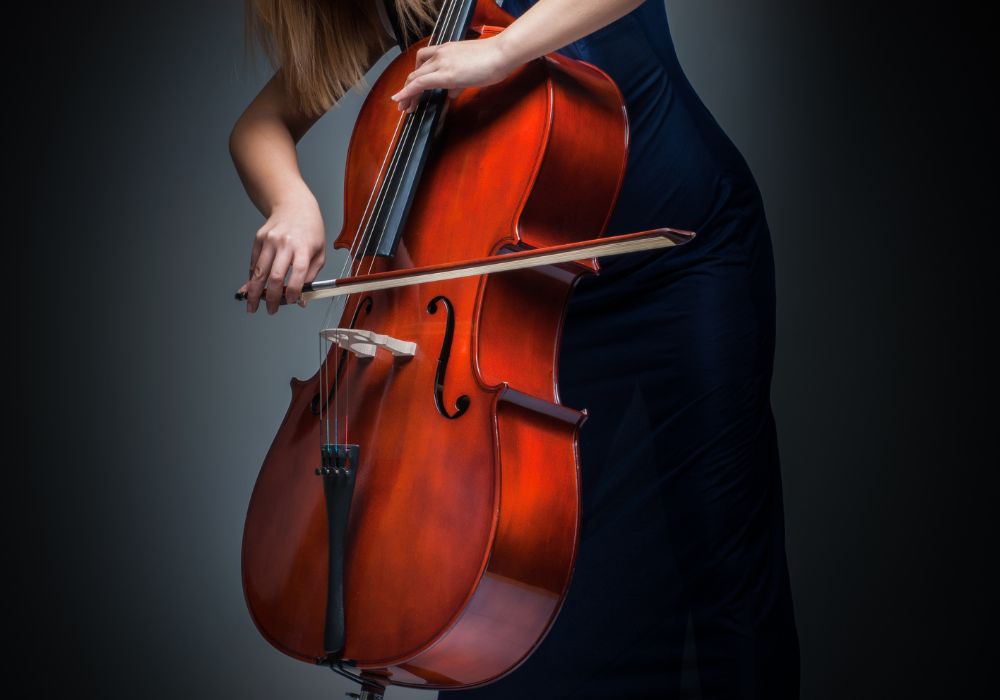
In modern society, the cello is featured in music all across the board, from hip-hop to heavy metal.
Its limitless versatility has strongly impacted the world to the point where it has driven the music industry to places where it’s never been before. For example, bands like Apocalyptica and 2Cellos are famous for their rock covers ranging from Metallica to Michael Jackson.
From my personal experience, I find that the cello is the most soothing of all the classical stringed instruments. As the cello rests on your chest, the vibrations surround your heart and ring from head to toe. You can literally feel the notes as you play, and that’s why I’m a cellist.
Types of Cellos
As music genres have progressed over the years, so have different types of cellos. We all know that wood is by far the go-to for anyone picking up the cello for the first time as well as professionals.
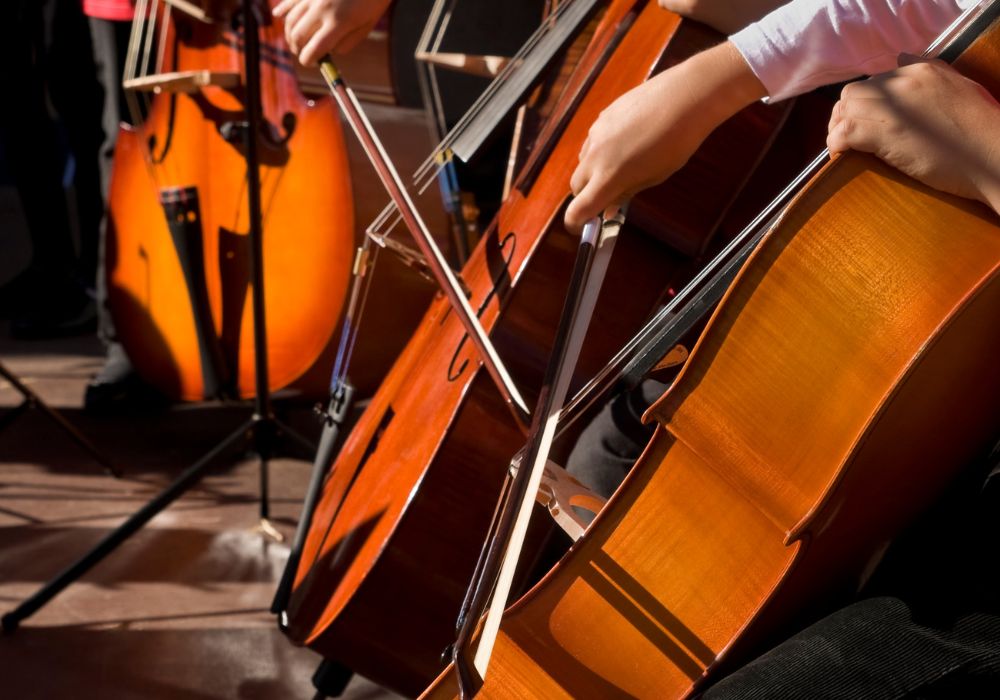
Wood is essential for the feel — both physically and mentally. To simulate this feel, Luis & Clark brought us the carbon-fiber cello. If you wanted to amplify your rock music, you could pick up an electric cello.
Classic Wooden Cello
The first type of cello is, of course, the classic wooden cello. Many types of woods are carved to perfection to achieve a wide variety of sounds and feel.
No two wooden cellos sound the same. Commonly used woods are spruce, maple or flamed maple, ebony, poplar, willow, and basswood. My favorite wooden cello that I currently own is made by Andreas Eastman.
Carbon Fiber Cello
Next is the carbon fiber cello, invented by Luis & Clark. The carbon fiber cello is completely acoustic and sounds absolutely amazing in any venue.
Made from only carbon fiber and a wooden bridge, it’s capable of putting most wooden cellos through the grinder. This is the main cello that I use daily.
Electric Cello
Last we have the electric cello, which is made by a wide variety of brands. I’d say the best is the Yamaha Silent Series. Most of the time they look quite bizarre but sound awesome through an amp. Without an amp, I’m afraid the electric cello is useless, as it contains zero acoustics.
Things to Consider When Choosing a Cello
As with any instrument, when it comes to choosing the best cello and cello brands, there are some things you’ll want to consider.
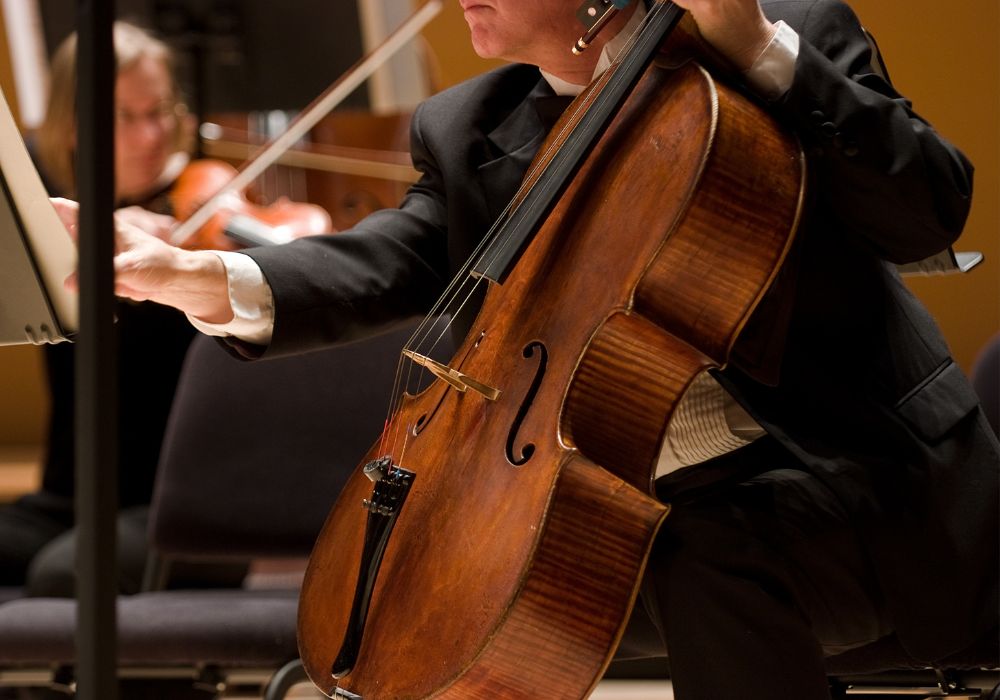
Level of Experience
It’s crucial to find the best cello and cello brand based on your personal skill level, which is why there are so many to choose from. So what makes a beginner cello for beginners and professional cellos for professionals?
Beginner Cellos
Beginner cellos are perfect for those that are unsure if the cello is for them or not. They’re made with cheaper materials and are usually manufactured instead of handmade.
For example, they substitute high-quality black ebony for other woods used for the fingerboard. Other woods are dyed black to appear to be ebony. Lower quality strings and bows are often sold with them.
As per tradition, cellos are inlaid with ebony around the edges for aesthetic purposes. Beginner cellos are usually lined with a Sharpie marker. Beginner cello usually costs no more than $500-600.
Intermediate Cellos
Intermediate cellos are certainly an upgrade in terms of materials used to build them. Intermediate cellos are usually a mix of handmade and manufactured.
For example, most of the body of the cello may be handmade but might include manufactured bridges and tailpieces. Ebony substitutes are found in many intermediate cellos as well. These cellos should be in the range of around $1,000-7,000.
Professional Cellos
Professional cellos are 100% handmade and finely tuned to perfection. Every carve in the most expensive wood has a purpose and meaning. Every bridge holding up the best quality strings is handmade for that cello in particular.
You’ll find that the majority of professional cellos are 50-100 years old at least because aged wood starts to create its own personality.
Professional cellos can cost you hundreds of thousands of dollars. Some of the best cellos in the world are priceless.
Size
The size of your cello is probably one of the most important things to take note of when first starting. It’s absolutely key that you find a cello that’s the correct size for your body.
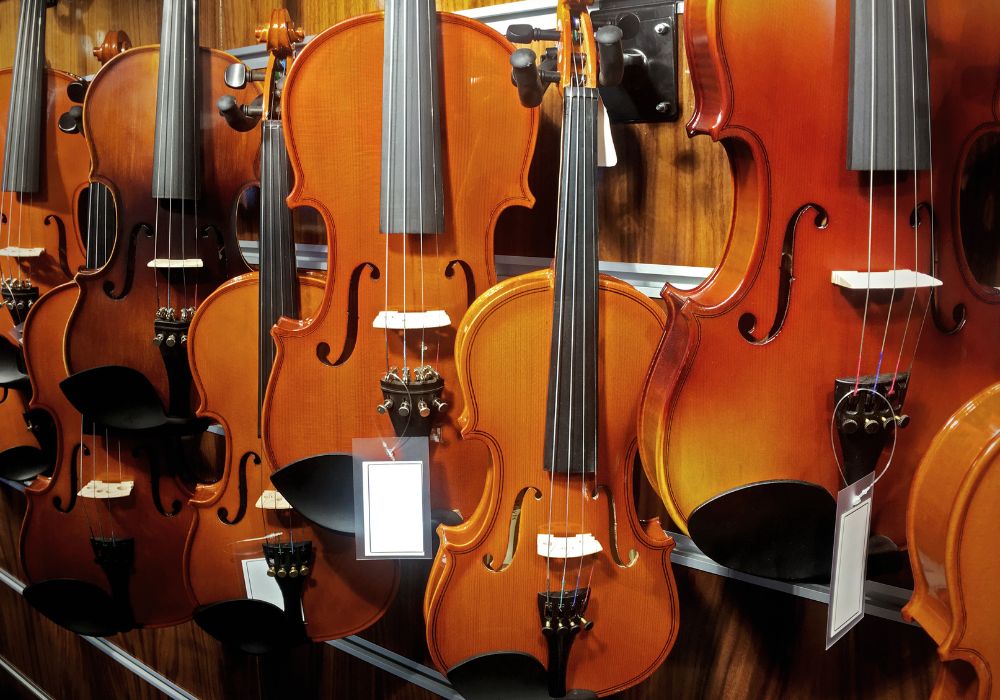
Age is usually the best way to determine the size of the cello you need. From my experience in teaching and playing the cello for nearly 20 years, age hasn’t let me down once! Here’s how to determine the size of cello for you:
1/10 Cello = 3-5 Years Old
1/8 Cello = 5-6 Years Old
1/4 Cello = 6-7 Years Old
1/2 Cello = 8-10 Years Old
3/4 Cello = 11-13 Years Old
4/4 Full Cello = 14+ Years Old
Wood
As I mentioned before, the cello can be handmade or manufactured from a wide variety of different woods. Traditionally, most mid to high-end cellos are made with spruce for the tops and maple or poplar for the sides, back, and neck. Also, they’re artistically inlaid with ebony and have ebony fingerboards and tailpieces. Low-end cellos are typically made with laminated wood.
Woods like spruce, maple, ebony, and poplar have proven to produce the best sounds acoustically. These woods also age well, making them sound even better over time.
Finish
Different varnishes look amazing with different woods and are quite important for keeping the wood safe from moisture, abrasion, and dirt.
While commercial varnishes are extremely strong and durable, they tend to heavily dampen the vibrations and sound of the instrument. To combat this, most luthiers I’ve met over the years have invented their own varnishes when building their instruments.
If you aren’t experienced in carpentry and varnishing, I strongly recommend getting it re-varnished by a professional luthier if possible.
Color
Cellos are typically some sort of brownish tint with some hints of orange, red, or a mix of them. The color of your cello is strictly aesthetic and serves no purpose for the quality of your cello. Don’t let color get in the way of how your cello sounds. You can’t judge a book by its cover.
You may find some cheaper cellos on Amazon that might be painted black, purple, red, or green. I don’t recommend them, as they’re typically very low quality.
The Bow
As a cellist, I can tell you that the bow is as important as a wand to a wizard. Without the right bow to go with your cello, the magic won’t cast as well as it should.
Cellos respond differently to different bows, and the most expensive bow won’t always sound great with your instrument. I used a $16,000 bow on my $5,000 Eastman cello, and it didn’t sound even remotely as good as my $800 Eastman bow.
Here are some measurements on proper bow lengths according to cello size:
1/10 Cello = 17.5″/44.4cm Bow
1/8 Cello = 20.75″/52.7cm Bow
1/4 Cello = 23.75″/60.3cm Bow
1/2 Cello = 25.5″/64.7cm Bow
3/4 Cello = 27″/68.5cm Bow
4/4 Full Cello = 28″/71.1cm Bow
Rosin
What is that sticky stuff, you ask? That’s rosin, which is a solid form of resin that’s from pine and other conifers.

Rosin is put on the bow for the bow hair to stick to the strings. Without rosin, your bow wouldn’t make any sound. Rosin is also an important factor to take into account, as bows and cellos respond differently to different types of rosin. Rosins can cost from $10 per cake all the way to $100.
The Overall Tone & Sound
The tone and sound of the cello usually depend on what the cellist prefers. I personally like my cellos to have very deep lows and warm highs. Some cellists may prefer very bright cellos that scream in high ceilings.
Note that strings typically make a huge difference in the sound of your cello. I suggest experimenting with different strings such as Larsen, Solo Larsens, Jargar, Thomastik, and Pirastro.
With both my Eastman and carbon fiber cellos, I use mediums in Solo Larsen A and Larsen D with Jargar G and C.
Strings
Now to one of the more frustrating experiences I’ve encountered as a cellist, buying cello strings. I may sound like a broken record, but bows, cellos, and rosin respond differently to different cello strings, and cello strings aren’t cheap. Top-of-the-line cello strings will cost you $50-$60 per string.

But I wouldn’t worry about cello strings too much when starting. If you break a string, some brands of cello strings cost $10 or less per string, so you can relax about that.
For beginner strings, I recommend looking into D’addario Helicore, Merano, and Thomastik.
Price
Without a doubt, a cello is an expensive investment. Professional cellos are sold for up to $1 million. Even “cheap” cellos can cost you no less than $1,000.
There are certainly options to rent cheaper cellos at your local music stores, like Guitar Center. However, renting a cello, more often than not, will end up costing you more than the cello itself.
For the more expensive cellos, most of the time there are financial options available.
The cheaper the cello, the cheaper the materials used to build it. Therefore it won’t sound and feel like a more expensive cello. Also, the tougher the music gets, the harder it is to play on a cello that costs $200.
Extras
Most beginner cello packs will give you all the essentials you need except for music. Depending on where you live in the world or who your teacher is, the music will differ as well as the teaching methods.
New vs Used
I believe it’s of utmost importance to buy a beginner cello brand new. Most new students with their first cello most likely don’t know how to properly take care of it.
You don’t want to be stuck with a messed-up beginner cello making your first experience a bad one. If you’re looking to buy a used beginner cello, I strongly recommend showing it to someone who’s experienced.
As far as intermediate to professional cellos go, the older the cello, the better it sounds if properly taken care of. Finding a used cello can be more difficult, but aged wood is good wood!
Best Cello Brands
All brands, whether they’re for musical instruments or food products, have knock-offs. Some knock-offs are actually not too bad given their price and quality.
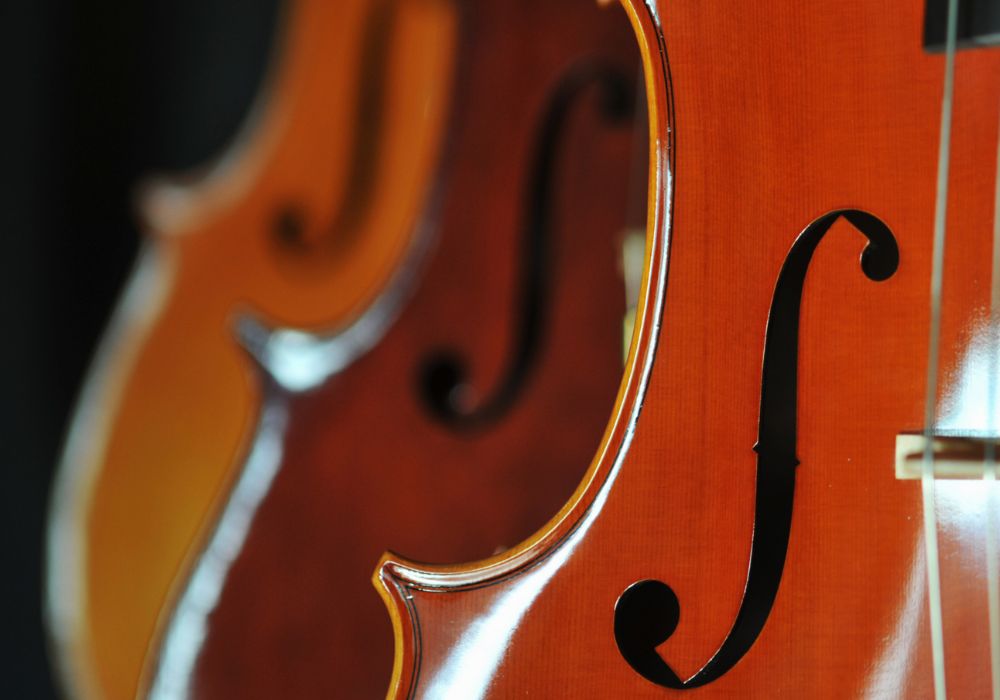
Here’s a list of some cello brands I personally recommend for beginners to professional cellists. I recommend these brands because they’re consistent with their quality.
Eastar
Eastar EVC-1 is listed as my best cello under $500. Although this brand only makes one cello model, it’s rare to find a handmade cello strictly built for beginners.
Besides being built with quality woods, it comes with a decent bow, rosin, extra strings, a music stand, and 6-month product warranty upon purchase for just below $300. Amazon reviews give this cello 4 stars out of 5, but I’m willing to give it a 5 out of 5.
Merano
Merano is known to produce affordable and decent quality instruments. It’s an extremely popular brand amongst starting cellists and one brand I’ve repeatedly recommended to my beginner students.
Cecilio
Cecilio is an excellent brand on the market for all starter instruments from strings to brass. It has a wonderful projection of sound and comes with a Brazilwood cello bow, a cello stand, a soft case, an extra set of cello strings, and high-quality rosin cake.
When searching for a specific Cecilio cello, look for the Cecilio CCO-100. This cello in particular costs around $500 and won’t disappoint.
Cremona
Cremona cellos are perfect for students getting into a high school level of playing. I picked this brand as my best intermediate cello, as they have ebony fingerboards, a wonderful tone, and a comfortable string height for ease-of-play.
The Cremona SC-165 cello costs around $800 and is well worth it. I love this cello so much that I almost purchased it going into Governor’s School for the Arts in Greenville, SC.
Eastman
Eastman became my most beloved cello brand, and it barely surpassed my urge to go for Cremona. Eastman is easily my best overall cello and cello brand for this list.
Eastman Strings has a lineage that traces back to the late 16th century. They hand make their instruments with utmost finesse and care for their customers. For those willing to spend $2,000+ for an amazing cello, I highly recommend it. My $6,000 Eastman cello has lasted me over 15 years and keeps getting better as time passes.
DZ Strad
Attention to detail is the name of the game for the cello brand DZ Strad. I labeled this cello and cello brand as the best cello for professionals mainly because of its price and quality.
With Italian tonewoods aged 20 years before being used, personality is already embedded. These instruments sound incredible even brand new and will only get better. If you want an “affordable” cello for the rest of your cello career, I recommend checking out DZ Strad. Cellos range from $1,200 all the way to $30,000.
The Best Cello Overall
We’ve finally reached the nitty-gritty of why I believe these cellos should be on my list. But, there’s a standout for me and the best overall cello is listed here — I’ve had mine for nearly 20 years.

 Eastman VC305
Eastman VC305
- Size: 1/4 – 1/2 – 3/4 – 4/4
- What’s included: The cello
- Material & finish: European or Chinese spruce, maple, and ebony. Shaded spirit finish.
The Eastman VC305 is one of the more popular intermediate/professional cellos handcrafted from Eastman Strings. Along with its excellent tone and beautiful finish, this cello feels amazing to play on. My Eastman VC305 has never once disappointed me through my time in Governor’s School and the Cincinnati Conservatory of Music.
✅ Warm tone and robust high notes
✅ Affordable for intermediate/professional
✅ Amazingly handcrafted
✅ Fingerboard and string height feel great
❌ Nothing
Why I Recommend It
The Eastman VC305 is the perfect cello to bring your cello game to the next level. It’s affordable, sounds amazing, and looks fantastic. It’s highly recommended for intermediate players and professionals alike.
Best Beginner Cellos
These are the top three beginner cellos that I’ve personally recommended to my students over the years. All of the beginner cellos listed are of solid quality, highly affordable, and the perfect start to your cello journey.

 Merano MC400
Merano MC400
- Size: 1/4 – 1/2 – 3/4 – 4/4
- What’s included: Soft cello bag, music stand, rosin, bow, two sets of strings, mute, and tuner
- Material & finish: Spruce top, maple back and sides, ebony pegs and fingerboard
The Merano MC400 is the best cheap cello on my list, and it comes in a fantastic starter pack. With this entire package, you’ll undoubtedly be in great hands. It feels very comfortable for beginner students, and it’s never disappointed me with its tone and ability to play some decently hard passages of music.
✅ Feels great
✅ Affordable
✅ Solid build quality
✅ Comes with everything you need to start
❌ The bow included is low quality
❌ May come without a bridge placed. Visit luthier.
Why I Recommend It
The Merano MC400 comes with everything you need to start playing the cello without the hassle of worrying about where to put your music or how to keep your cello in tune.
So many of my students over the years have begun their cello journeys on Meranos, and when I see them years later, I’m often surprised to see that they’re still using their first instrument. That’s how durable and reliable they are.

 Cecilio CCO-100
Cecilio CCO-100
- Size: 1/4 – 1/2 – 3/4 – 4/4
- What’s included: Brazilwood cello bow, a cello stand, soft case, an extra set of cello strings, and high-quality rosin cake
- Material & finish: Spruce top with maple back, neck, and sides
The Cecilio CCO-100 is the best beginner cello, and I recommended it to 100% of my new students. Like the Merano, it’s another great starter cello for those on a slight budget who want a decent quality instrument. It comes with all the essentials you need. If you don’t want to take my word for it, I suggest checking out Amazon reviews, as they’re overwhelmingly positive.
✅ Solid build quality
✅ Sounds great
✅ Comes with essential materials
✅ Brazilwood bow is quite nice
❌ May come without a bridge placed. Visit luthier.
❌ Lacks ebony wood
Why I Recommend It
Because of my personal experience, I rate the Cecilio CCO-100 the best of the beginner cellos on this list. Cecilio makes solid instruments and I trust their quality hands down. Quite a few of my students have been happy with the CCO-100, so as a teacher, it makes me happy as well. Highly recommend it!

 D’Luca MC100 Meister
D’Luca MC100 Meister
- Size: 1/4 – 1/2 – 3/4 – 4/4
- What’s included: Mongolian horsehair ebony bow and featherweight cello case, stand, soft case, strings, tuner, and rosin
- Material & finish: Spruce top with maple back, neck, and sides. Ebony fingerboard and pegs.
Labeled as my best cello under $1,000, the D’Luca MC100 Meister is a must when you’re checking out beginner cellos. It has great quality wood and ebony all-around. Simply put, it feels great, and new students love it.
✅ Great sound
✅ Easy to tune pegs
✅ The ebony bow is balanced and feels good
❌ Bridge and tailpiece don’t come installed to prevent damage
Why I Recommend It
For a beginner cello, it has definitely managed to impress me over the years. I love its good balance of classy looks and approachable playability. Even though it’s a budget cello, if you can get it supercharged by a professional luthier, over time this cello can accomplish some amazing feats.

 Eastar EVC-1
Eastar EVC-1
- Size: 1/4 – 1/2 – 3/4 – 4/4
- What’s included: Bow, rosin, extra strings, music stand, and 6-month product warranty upon purchase
- Material & finish: Matte natural varnish. Cello is made of spruce wood panels, maple backboards, and side plates.
The Eastar EVC-1 is the most affordable beginner cello on this list, and in my opinion it’s the best cello under $500. Although this cello is the cheapest, you’ll still be surprised at what this cello is capable of. The wood is of a surprisingly decent quality, and the build and construction is much better than you’d expect from a discount cello.
✅ Most affordable
✅ Decent wood build
✅ Comes with essential materials
❌ Tone is lacking
❌ The bow isn’t the best
Why I Recommend It:
For such an affordable cello, it’s surprisingly well built and regardless of price, is still a great bet for beginners. While it’s not quite as popular as its counterparts from Cecilio and Merano, many of my students have brought this cello to their lessons. I’ve always enjoyed trying it out, and I’ve frequently been astonished by its price to quality ratio.
Best Intermediate Cellos
Now let’s dive into what I believe are to be the best intermediate cellos featured on this list. You’ll find that intermediate cellos are made with a little more love, handcrafted with finesse, and come with better quality woods, strings, and bridges.

 Cremona SC-165
Cremona SC-165
- Size: 1/4 – 1/2 – 3/4 – 4/4
- What’s included: Hardshell foam case and bow
- Material & finish: Solid spruce and maple
The Cremona SC-165 is my number one best intermediate cello for this list. With this intermediate cello, the handcrafters at Cremona take special care in making sure string height and spacing are perfect for accurate finger positions and intonation. Costing just over $1,000, this cello will certainly bring you more bang for your buck.
✅ Affordable intermediate cello
✅ Great quality wood and tailpiece
✅ Comes with a hard shell foam case
✅ Feels great with an excellent tone
❌ The bow is low quality
Why I Recommend It
After playing on several Cremona cellos during my classical endeavors, I can say that nothing really beats this intermediate cello in terms of cost and quality. I’ve always been very happy with the way this cello feels and sounds in concert halls. Be sure to keep this cello in mind when you start diving deep into Suzuki Methods.

 Knilling Bucharest Model Carved Cello
Knilling Bucharest Model Carved Cello
- Size: 1/4 – 1/2 – 3/4 – 4/4
- What’s included: Carbon fiber bow and perfection pegs
- Material & finish: Spruce top with maple back, neck, and sides
The Knilling Bucharest Model is not only a wonderful intermediate cello, but it’s also great as a higher-end beginner cello. Its high-quality woods and ebony fingerboard, nut, and tailpiece give this cello a very nice explosive sound. With a price tag of around $1,600, any intermediate cellist would be overjoyed to get this in their hands.
✅ Excellent carbon fiber bow
✅ Professional-looking finish and build
✅ Great sound
✅ Has perfection pegs
❌ The strings aren’t the best quality
Why I Recommend It
My number reason for including this cello on my list of best cellos and cello brands is because of the perfection pegs that are included. Perfection pegs are geared so they will never slip on you, putting your cello out of tune. This is an amazing feature, especially for beginners. The lightweight carbon fiber bow is also a solid addition!
Best Cellos for Professionals
Cellos made for professionals are an entirely different beast when it comes to how they feel and sound. As I mentioned before, these types of cellos are born and bred with their own personality. Let’s take a look at what some master crafters have to offer.

 DZ Strad Cello Model 250
DZ Strad Cello Model 250
- Size: 1/8 – 1/4 – 1/2 – 3/4 – 4/4
- What’s included: An amazing cello
- Material & finish: Aged tonewoods
This 100% handmade and hand oil-varnished cello is downright awesome in every way, simply put. Costing around $2,500-3,000, this cello will bring you years of beautiful music and joy. It’s perfect for any advanced player no matter what size or age you are. If you need a 1/8 size DZ Strad, they’ve got you covered.
✅ An excellent tone that gets better over time
✅ Aged tonewoods and ebony all-around
✅ Professionally handmade and hand varnished
❌ Nothing
Why I Recommend It
The DZ Strad Cello Model 150 is up there with some of my favorite cellos I’ve ever played, and in fact I chose it as the best cello on this list. If you want a cello that’s amazing inside and out, this is the one for you. $2,500 or so is cheap compared to what this cello can do for you and how long it’ll last.

 Ivan Dunov Superior VC402
Ivan Dunov Superior VC402
- Size: 4/4
- What’s included: An amazing cello and high-quality strings
- Material & finish: Romanian spruce and maple with antiqued spirit varnish
The Ivan Dunov Superior has a reputation in the “cello world” for being the best cello there is under $5,000. This cello is a real wizard as far as sound quality and projection, and it looks gorgeous as well.
Carefully handcrafted in Romania and finished in the US, if you’re looking to take your cello career to the next level, give cello a look.
✅ Superior tone and projection
✅ Superior look
✅ Superior feel
✅ Comes with high-quality strings
❌ Expensive
Why I Recommend It
Quite a few of my friends from the conservatory have this Ivan Dunov cello and love it. I’ve had many chances to try it out, and I love its warm, full, striking tone.
You should also know that this cello comes with Larsen A + D and Spirocore G + C already installed, which are great high-quality strings. Basically, this is a fantastic cello that will please even the most demanding cellists.
Best Carbon Fiber Cello
Let’s take a break from wood and get into something a little more modern: carbon fiber. Not only is carbon fiber super lightweight and looks awesome, but acoustically, it’s truly a monster.
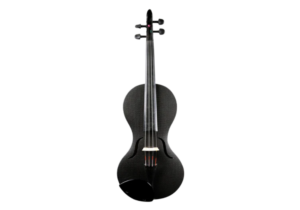 Mezzo-Forte Carbon Fiber Evo Line Cello
Mezzo-Forte Carbon Fiber Evo Line Cello
- Size: 1/2 – 4/4
- What’s included: Carbon fiber cello
- Material & finish: All carbon fiber
- Best for: Great for all players from beginner to professional
The Mezzo-Forte Carbon Fiber Evo Line Cello is the main cello that I play and teach on daily. It has an amazing projection, and it looks super cool and super sleek. This cello is also immune to heat and cold, as it contains almost no wood to warp or break. Four strings not enough? Mezzo-Forte even makes and sells a 5-stringed cello.
✅ Incredible projection
✅ Feels like a wooden cello
✅ Sounds like a wooden cello
✅ Immune to the elements
❌ None. But I did get funny looks from fellow orchestra members. Ok, boomer.
Why I Recommend It
I once emailed Stjepan Hauser from the duo 2CELLOS and asked him if it was worth looking into a Mezzo-Forte cello. He responded, “If you can’t afford a $100,000 cello, then get one of these.” So…I got one.
Best Electric Cello
Next, we have the electric cello. Let’s take a look at what electric cellos are used for, what they’re made of, and what they’re capable of.

 Yamaha Silent Series – Cello
Yamaha Silent Series – Cello
- Size: 4/4
- What’s included: Studio-quality onboard preamp and built-in reverb
- Material & finish: Spruce and maple
- Best for: Great for players of all levels of experience. Best for rockers.
Specifically, the Yamaha Silent Series of electric cellos have proven to be the best when it comes to electric cellos on the market.
Coming in various looks, shapes, and sizes, these cellos are monsters when plugged in and as silent as a mouse if you need to practice without waking up the neighbors. With its onboard preamp and built-in reverb, these electric cellos sound the best.
✅ High quality if not the best for electric cellos
✅ Look super cool
✅ Sound awesome
✅ Rocker certified
❌ You most certainly need an amp
Why I Recommend It
I’ve always been inspired by what the electric cello is capable of, and I’ve always gotten a kick out of playing them when I’ve had the chance. You may hear electric cellos in bands such as Smashing Pumpkins, One Republic, 2Cellos, Trans-Siberian Orchestra, and many more. There is no limit to what these cellos can do.
What Should Come with a Beginner Cello?
Beginner cello packages will most likely come with the complete essentials that you need to get the ball rolling. Things you need to look for include a bow, rosin, a music stand, a tuner, a mute, and a case.

Bow
Most of the time, the bow you’ll receive with your beginner cello will probably only be decent at best. The main thing you’ll need to look out for is bow warping, torn up or dirty bow hairs, and a functioning screw that tightens the hair.
If your bow is warped, it’s not a good idea to use it, as it will most likely break or snap while you’re playing.
If the bow hairs are dirty or breaking easily, I suggest looking into getting it replaced. Dirty or oily bow hairs will render rosin useless.
A malfunctioning screw to tighten your bow hairs is also a red flag. You’ll need to get it fixed by a luthier, or you should look into getting a new bow. Sometimes it costs more to get it fixed than to get a new cheaper bow.
Rosin
Rosin is crucial, so make sure it’s included in your package. Don’t worry if your rosin gets broken a little bit. You can melt it back together with a hairdryer. Just make sure not to drop it, as it’s extremely fragile.
Music Stand
Having a music stand makes life so much easier, as does it make practicing a lot easier. If you have to read your music from a table or another makeshift place to hold your music, it can be a pain and unreliable.
Tuner
Getting a tuner with your new cello is also a bonus. But if the tuner isn’t included, you can use YouTube as your tuner if you have a good ear. I recommend checking out tuners with metronomes included like the KORG TM series.
Mute
Mutes can be super useful if you live in an apartment complex or just need to stay quiet when practicing. Mutes are usually rubber attachments that attach to your bridge. They come in different metals that work to varying degrees, if you really need to stay extra quiet.
Case
Lastly, your beginner cello package should come with a case of some sort. Common cases you’ll find are soft bags or hardshell foam. This is necessary when carrying your cello around places.
If you receive a soft case, always remember, take the bow out first and then the cello. When you’re done practicing, put the cello in first, then the bow.
Cello Brands to Avoid
While I don’t have any specific cello brands to avoid in mind, there are some cellos that you should avoid — ones that are painted in different colors and super cheap cellos that are made from laminated wood.
You want to stay away from painted cellos, as the sound quality is usually very bad. This is strictly an aesthetic addition and does absolutely nothing for the sound. If anything, it makes the cello sound worse.
Laminated wooden cellos are also a huge red flag, as laminated wood is very weak and can break or crack easily.
Cello Parts & Accessories
All parts listed below are absolutely crucial to how the cello works and sounds. So take care of them!
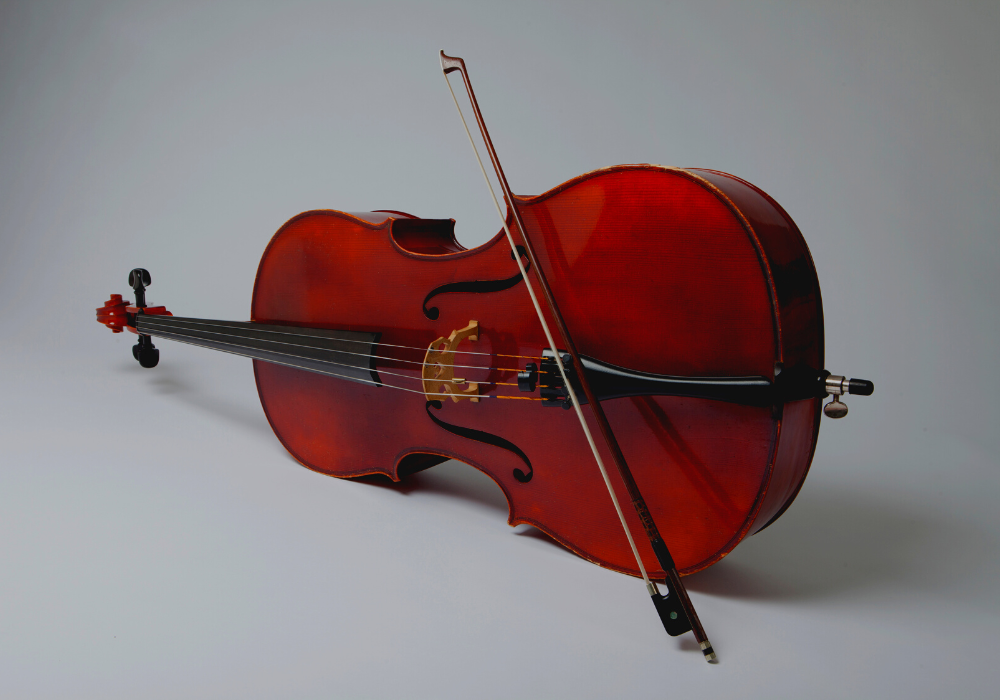
Bridge
The bridge on the cello is what holds and separates the strings. Over time, the bridge can warp due to weather or moisture, so be sure to keep your cello at room temperature. You can also look into getting a dehumidifier. If your bridge does end up warping, don’t try to bend it back. You’ll need to get another bridge from your luthier.
Pegs
The pegs are what keep your cello in tune. Pegs are usually made of ebony, as they need to be quite tough to hold the tension of the strings. Pegs are held by friction, so sometimes they slip. This is why I highly recommend perfection pegs, as they’re made with gears inside. No friction, no problem.
Tailpiece
At the bottom front-end of the cello is the tailpiece. The tailpiece is the end-point where the strings are attached. You can also use the tailpiece to find the fine tuners. The fine tuners can help tune your strings in extremely small increments.
Endpin
Back when the cello was first invented, it was held between the performer’s legs. Luckily, we’ve invented endpins that hold the cello up for you. Sometimes endpins are heavily sharpened to prevent your cello from slipping. Most of the time people use rock stops.
Rock Stop
A rock stop is a rubber device that’s used to keep the endpin from slipping on smooth surfaces. Rock stops come in different shapes and sizes, so look around for one that suits you best. They can be small and circular, and they can attach to your endpin or be strapped to your chair.
Soundpost
The soundpost is the secret ingredient to any acoustic stringed instrument in the violin family. If you look inside of your cello, you’ll find a stick of wood wedged between the front and backside of the instrument. This is extremely important to have, as it makes the sound vibrate and resonate throughout the cello.
Sometimes the soundpost will fall if there isn’t enough tension due to loose strings or expanding wood. If it falls, only the luthier can fix it.
Frequently Asked Questions:
Have any questions so far? Well, here are some commonly asked questions you may be wondering about.
What Are the Best Cellos?
In this list, I’ll tell you the 3 top cellos that I highly recommend looking into for players of all skill and experience levels.
Cecilio CCO-100: Best Cello for Beginners
Overall, the Cecilio CCO-100 is the best cello for beginners in terms of build quality and sound. This cello will last you quite a while, and if taken care of, can be handed down to future cellists as you once were. It’s affordable and comes with everything you need, including a soft case, cello stand, bow and rosin.
DZ Strad Model 250 Handmade: Best Cello Overall
Countless of my cello-playing colleagues over the years have used this DZ Strad, and it deserves its place as the best cello overall. This is an excellent cello for intermediate to professional players. It has incredible handcrafted woods and a beautiful tone, and it’s even easy to play.
Mezzo-Forte Carbon Fiber Evo Line Cello: Best Carbon Fiber Cello
Not only does the Mezzo-Forte Carbon Fiber Evo Line cello sound absolutely incredible, but the elements are no match for it. You can take this cello almost anywhere without it getting damaged. It’s very lightweight, easy to carry around, and feels like an actual wooden cello. I stand by the statement, “If you can’t afford a $100,000 wooden cello, then get this.”
Where Are the Best Cellos Made?
The best cellos of all time were made in Italy by a Luthier named Antonio Stradivari. The Stradivarius cellos are so famous in fact that many professional luthiers today model their cellos after them.
Good luck finding an exact price on these beautiful instruments, as they’re truly priceless. However, to give you some insight into their value, the Duport Stradivarius Cello was bought by the Nippon Music Foundation in 2008 for around $20 million.
What is the Best Sounding Cello?
The best sounding cellos are usually the oldest, as aged wood becomes lighter, more responsive, and more resonant. This is another reason why Stradivarius cellos are considered the best, as they were professionally handcrafted in the late 17th and 18th centuries. They’re known to have impeccable sound quality.

While I’ve never heard a Stradivarius cello in person, I did hear a Stradivarius violin during my time in Italy. It was truly an amazing and emotional experience and one I’ll never forget.
But for us mere mortals, who will probably never get the chance to play a Stradivarius cello, much less even hear one in person, there are plenty of accessible and affordable options.
As you must have realized by now, I’m a huge fan of DZ Strad. Of the best cellos on this list, I think that the DZ Strad Cello Model 250 is one of the best sounding cellos commercially available. I recommend it to any intermediate or professional cellist.
On the more budget side of things, while its tone could never compete with a professional cello, the Cecilio CCO-100 sounds remarkably full and rich for a lower-price cello. I highly recommend it to newcomers to the cello, and I think you’ll be pleasantly surprised by both the price and the extras that come in the package.
Where to Buy Cellos?
Here I’ll discuss several places where you can buy your cello and what you should look out for when purchasing online or in person.
Amazon
I’m sure that most of you reading this have purchased goods off Amazon. But is it a good idea to purchase a cello from Amazon? From my personal experience, I’ve been quite pleased with them in terms of buying cheaper beginner cellos.
Honestly, Amazon is my go-to when recommending a beginner cello for newer students.
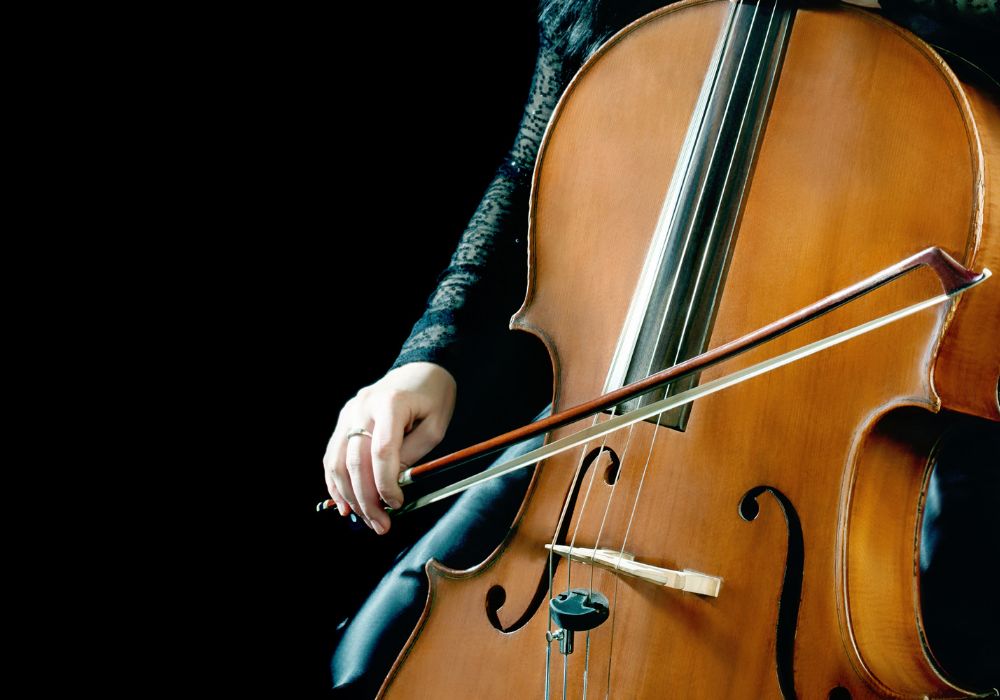
I have to say that it’s because of Amazon’s review system and return policy, which has made a solid impact on my decision to go with them first before other online music retailers or local music stores. This only goes for beginner cellos and cello brands such as Cecilio, Merano, and Eastar, however.
As far as intermediate and professional cellos go, you may find a great cello on there, such as the DZ Strad Model 250, but it may be better to opt for an online music retailer or a local music store.
Online Music Retailers
There are a handful of online music retailers that I suggest looking into for an intermediate/professional cello: Stringworks, FiddlerShop, Musician’s Friend, and Carriage House Violins.
These retailers are professionals in dealing with customers and trying to find the right cello for you. They also offer interest-free payment plans, financing plans, and simple applications, so everything is comfortable, fast, and easy.
Your Local Music Store
Visiting your local music store is still your best bet to find the perfect cello for you. Hopefully, your local music store will have some cellos that you can pick up and play on before purchase. This is the most ideal situation, as you can get a feel for the instrument and hear its sound. Then, make sure to compare prices with online retailers before you purchase.
If your local music store just doesn’t work out, then you may have to travel a bit to find what you’re looking for. For me, I once had to travel from South Carolina to upstate New York to find my perfect cello. It was a hassle but it was well worth it.
Review This Post
Table of Contents
- What is a Cello?
- Types of Cellos
- Things to Consider When Choosing a Cello
- Best Cello Brands
- The Best Cello Overall
- Best Beginner Cellos
- Best Intermediate Cellos
- Best Cellos for Professionals
- Best Carbon Fiber Cello
- Best Electric Cello
- What Should Come with a Beginner Cello?
- Cello Brands to Avoid
- Cello Parts & Accessories
- Frequently Asked Questions:
- In Conclusion
In Conclusion
Here at IntoStrings, we aim to give you the most helpful and accurate information about everything strings related, provided by actual string players.
In this article, my goal was to give you an overview of what you should look for when purchasing a cello as a beginner, intermediate, and professional cellist. I hope I succeeded.
I certainly understand if you still have questions, and I’m more than happy to answer any of these questions for you. If you liked this article or know someone looking to buy a cello, please share this with your friends and family so that everyone knows the smartest and safest ways to purchase a cello.












